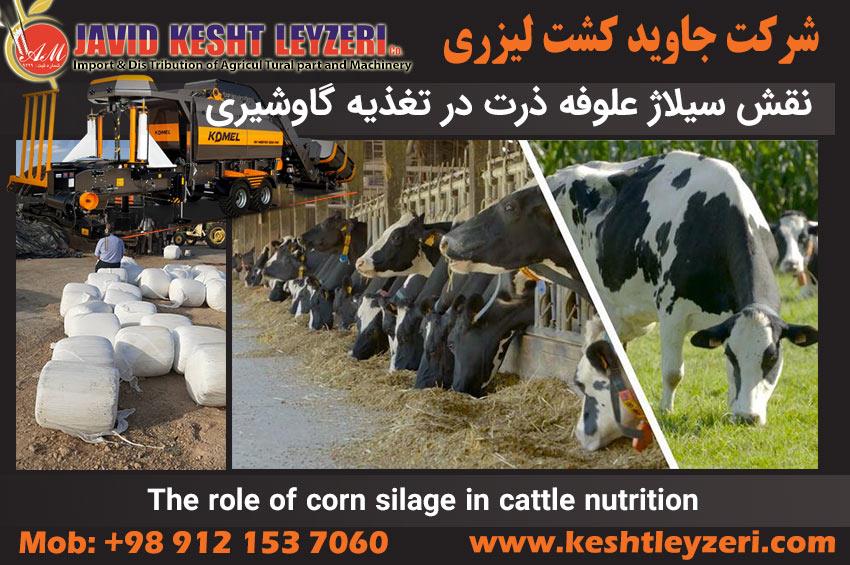
The role of corn silage in cattle nutrition
javid keshtleyzeri Co.ltd
The quality of corn fodder is unique in feeding dairy cows. This plant has a high nutritional value and contains large amounts of energy and starch.
This plant is able to produce 40 to 45 tons of fresh fodder per hectare and in some conditions even more than this amount, in other words, its production is 10 to 15 tons of dry matter per hectare.
According to the purpose of using the corn plant, the method of harvesting it is different:
Fresh corn fodder: Fresh corn fodder can be harvested at any stage of plant growth, even at the initial stage of growth.
In the early stages of fodder growth, corn has good nutritional value, but one should be careful not to consume a large amount of fresh fodder at once because it has compounds that are quickly digested, so it is recommended to eat more than 10 Kilograms of fresh fodder should not be given to livestock.
Corn silage forage
Harvesting corn seeds for silage should be done when they are ripe enough (hard dough stage).
Also, the optimal length of the pieces of chopped corn should be 8 cm.
This size is suitable for the preparation of silage and provides the possibility of sufficient compression of fodder in the ground silo building. It is very important that all corn kernels are handled well during the chopping stage. This action has made them more accessible to livestock during digestion because healthy and unprocessed seeds are not digested and are eventually excreted through feces.
The complaint that some colleagues have about corn silage due to lack of sufficient information is that
Why is silage low in grain?
In fact, it should be said, as it was said, corn fodder should be chopped when the corn seeds are pasty and in the pasty and milky area, that is, as soon as the pasty seeds are chopped, they are crushed under the chopper machine, and the nutritional value of the seeds is present in the whole silage. will be .
In preparing silage, the most important issue is its correct management, which includes:
harvesting fodder
Corn in the right stage of growth
Rapid filling and compaction of silos
Fast and suitable silage covering
Corn fodder must be harvested at a stage of plant growth that has 30-35% dry matter. This stage is when the leaves of corn fodder start to turn yellow from the bottom of the plant and the corn seeds are hard and pasty. otherwise, if corn fodder is harvested at a stage where its dry matter is less than 30%, silage waste will increase in the form of loss of nutrients through waste water.
Amount of silage consumption in ruminants (batakid on beef cattle)
This amount can vary greatly between different breeds of beef cattle.
In addition, according to the size of the cow, this amount will be different.
For example, a 150 kg cow eats 8 kg of corn silage daily, but a 550 kg cow will eat up to 25 kg of the same silage daily, which is equivalent to 3.5% of body weight at the beginning of the period and 4.45% at the end of the period.
So, if we check the amount of silage consumed as a percentage of body weight, we will see that this amount decreases as the cow matures and becomes heavier, but if we check the amount consumed in kilograms per day, we will see that it increases. So you see As the cow gets heavier, the amount of silage consumption increases.
The cattle breeding area is also not without influence. For example, the amount of consumption increases a little in colder weather.
Another factor is the type of silage consumed. For example, cows prefer corn silage to barley silage, and this shows that the type of silage also has an effect on the amount consumed. He says that maybe this law has lost its validity and the cows eat enough to be full regardless of the type of silage. Finally, the type of ruminant animal is also important. Cows always eat more silage than sheep and goats, and even if we examine this issue as a percentage of body weight, we will see that it is true.
To know how much dry matter a cow consumes per day, use the formula:
0 / 185 * cow's live weight = daily dry matter consumption of cow dung
We use . For example, a dry cow weighing 600 kg should consume 1/11 kg of dry matter per day. It is better that the fodder in this period is more than corn silage. The consumption of corn silage can be included up to 8 kg in this period, and the consumption of palatable alfalfa up to 3 kg per day does not cause a problem. Due to the palatability of silage It is better to consume corn in this period at the rate of 30% of the total diet or the same amount recommended above.






